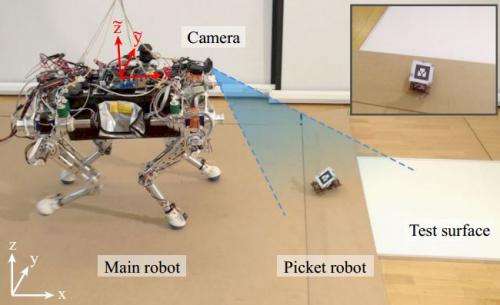June 12, 2014 weblog
Big to tiny robots on risky ground: You go first

Researchers have suggested an approach for protecting expensive components in big robots when on difficult terrain. Send in little, inexpensively made robots ahead of them as scouts. Whether the unanticipated risk is in the form of icy patches, sticky mud or rough obstacles, the little and expendable robots can be used for sending ahead of the big robots, for detection of hazards ahead. Researchers from the Biomimetic Millisystems Lab at the University of California, Berkeley and ETH Zurich presented their strategy at the IEEE International Conference on Robotics and Automation (ICRA) 2014 in Hong Kong, which took place from May 31 to June 5.
Their study titled "Detection of Slippery Terrain with a Heterogeneous Team of Legged Robots" is by Duncan W. Haldane, Peter Fankhauser, Roland Siegwart, and Ronald S. Fearing. They set in motion a heterogeneous pairing of a big, expensive robot with a cheap robot acting as terrain scout. Evan Ackerman, writing in IEEE Spectrum, said VelociRoACH was the robot of choice, made mostly of cardboard, which "you can just toss a bunch more into the mix to replace any robots that you may lose." VelociRoACH, from Berkeley, served as the picket robot, paired with the main robot StarlETH quadruped, from ETH Zurich, and running in front.
The video of their work showed a slippery floor. The system involved camera-tracking data and terrain classifier so that StarlETH knew where it was or was not safe to step. StarlETH watched VelociRoACH's back to see how the little robot was doing, but their system is actually quite collaborative. The researchers in their paper wrote, "Due to the limited capabilities of the picket robots, they depend on localization and guidance assistance from the main robot." They also explained, "The main robot runs an on-board state estimation and carries a downward-facing camera to track the smaller robot in front of it. The combination of on-board state estimation and visual tracking allows the main robot to steer and to localize the picket robot."
They noted how this type of joint perception was advantageous because the picket robot lacked the same capability for internal state estimation or remote sensing as the main robot. Ackerman reported that the robots can classify terrain as either slippery or safe to walk on with an accuracy of over 90 percent.
Future exploration, according to the researchers, will explore what they said were "path planning algorithms and picket robot formations which will more effectively detect hazardous terrain."
More information: Research paper: robotics.eecs.berkeley.edu/~ro … eth-roach-icra14.pdf
© 2014 Tech Xplore


















